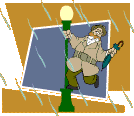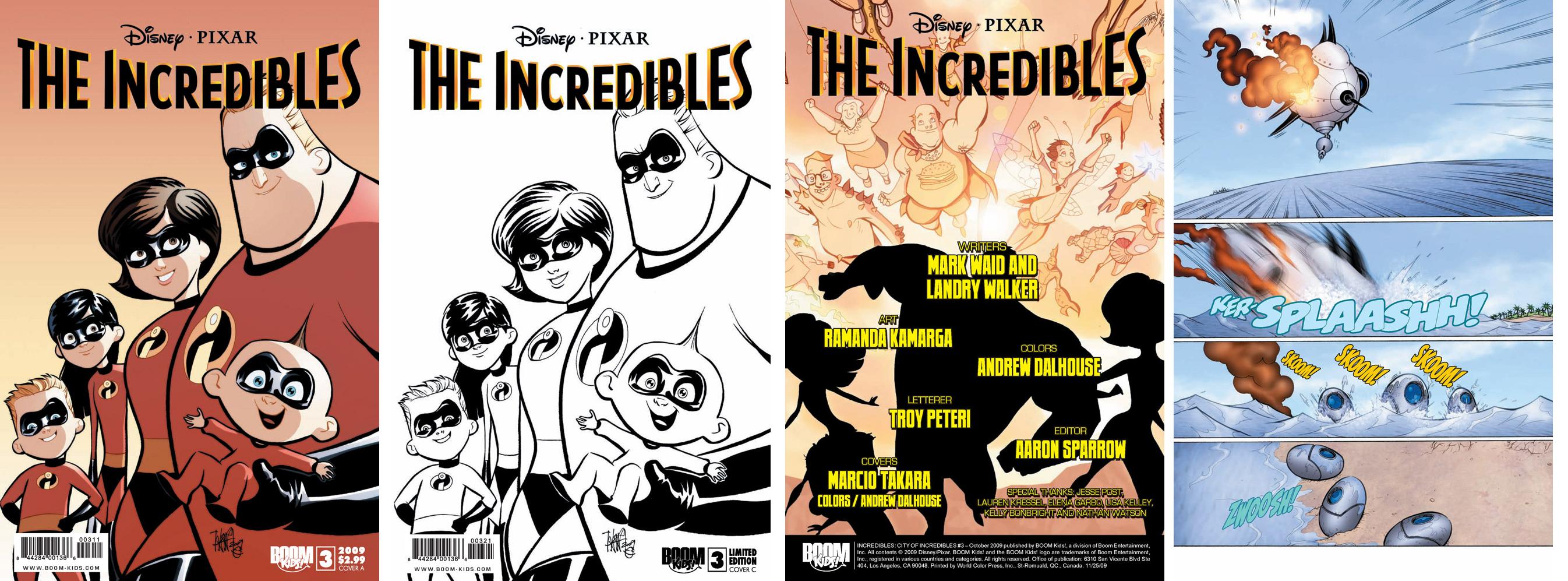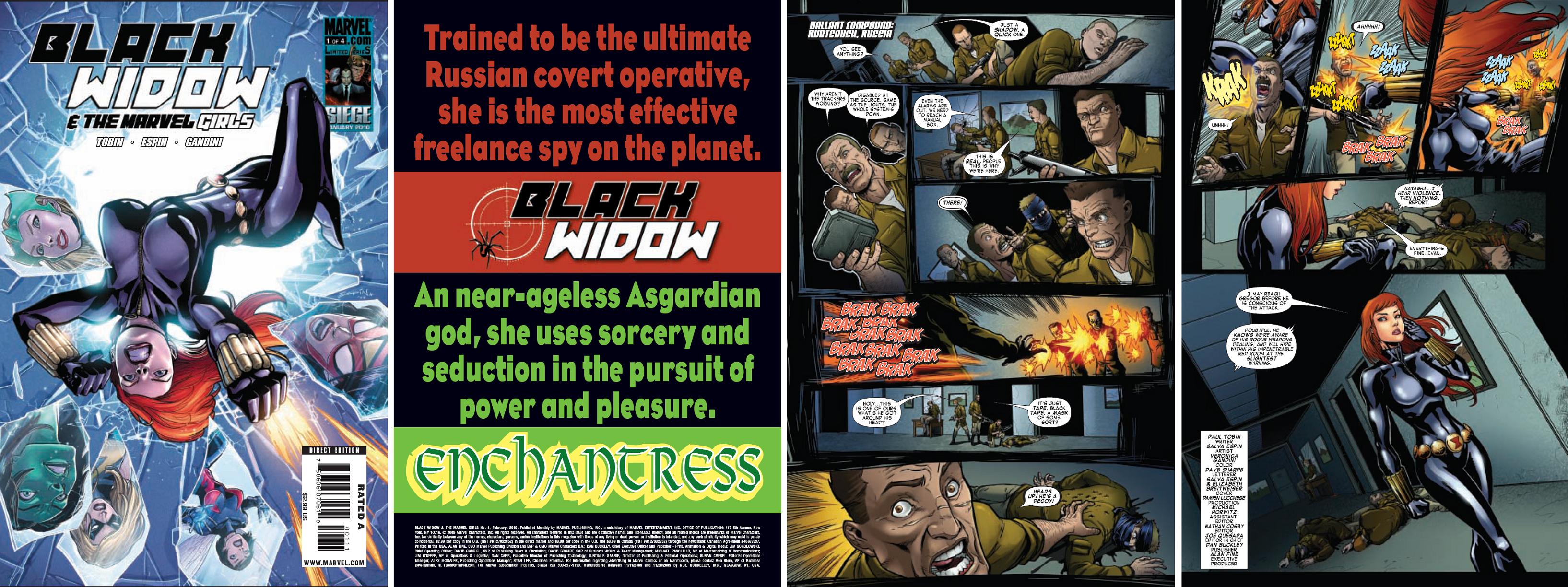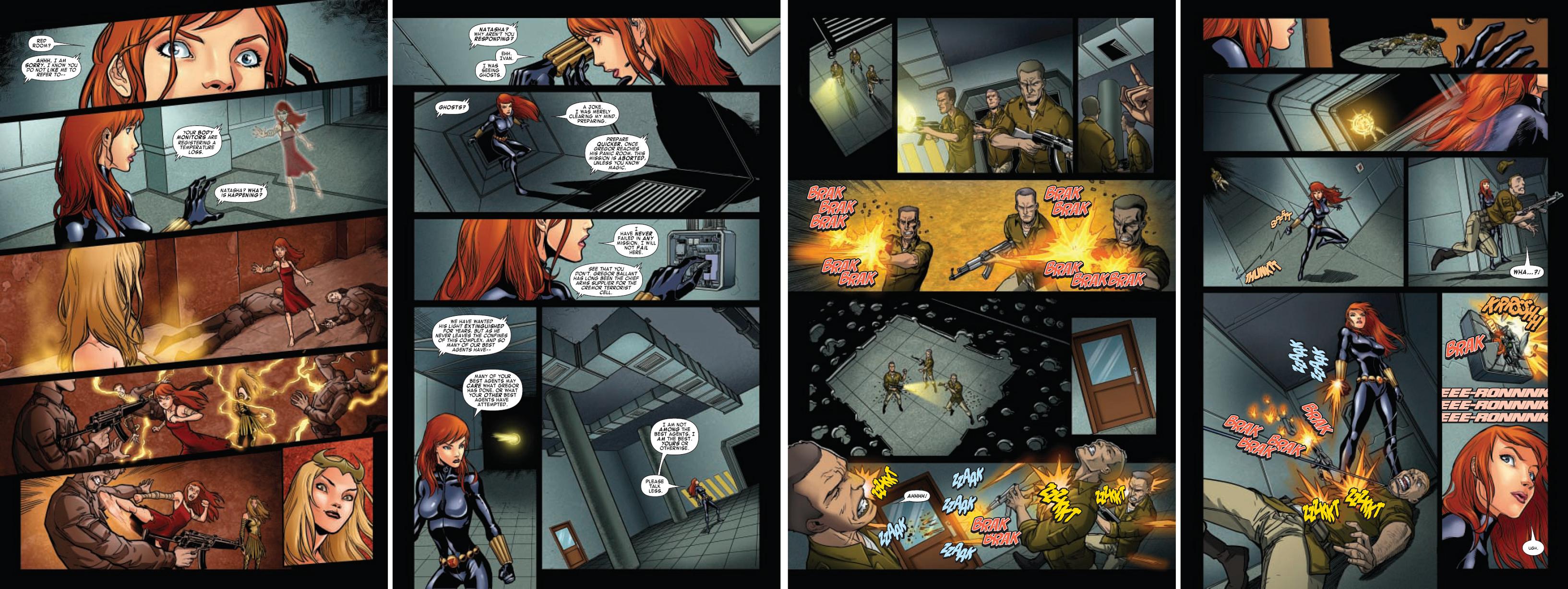
| #29 | 11/25/09 | #8 |
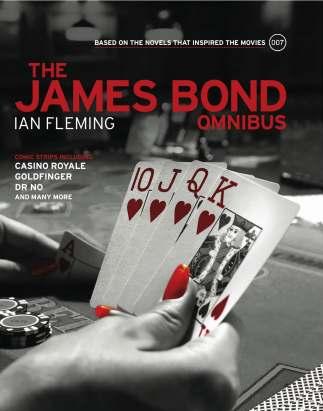
THE JAMES BOND OMNIBUS Vol. 001
Written by: Ian Fleming Adapted by: Anthony Hern, Peter O’Donnell and Henry Gammidge Illustrated by: John McLusky Published by: Titan Books Reviewed by: superhero
“Bond…James Bond.”It’s a phrase that’s as American as apple pie…
Er…what’s that? James Bond is British? Yeah, I knew that! I was just checking to see if you were paying attention!
No, really, I did know about James Bond’s nationality. How could I call myself any kind of comic/movie nerd and not know that? But what I do know of Bond is strictly from his movie incarnation. I’ve always been dying to pick up CASINO ROYALE and give it a read but every time I’m in a book store and I remember to look for it they always seem to be out of copies. So many of you out there would probably say that I don’t know the “real” James Bond and you’d pretty much be right about that. Regardless of that fact I do have to say that I love James Bond. From the moment that my folks took me to see MOONRAKER I’ve thought that James Bond was the bee’s knees. Yes, the movies have had their missteps (more than I’d care to count) but I’ve always loved the idea of James Bond. The lone secret agent. Charming but deadly. Keeping the world safe from the forces of evil…or at the very least cheesy mad scientist types. Bond opened up a new world to me when I was kid and while I can’t say that he stood alongside Superman in my fantasy hero canon I did think he was cool enough to enjoy several hours playing TOP SECRET as a teenager and, when it finally came out, I was actually the one guy who bought the James Bond role playing game.
So I was more than happy to get my hands on this book…and let me tell you this baby does not disappoint. THE JAMES BOND OMNIBUS reprints several old strip adaptations of the James Bond novels that first appeared in the British newspaper The Daily Express. These stories are very much different than the ones that I remember seeing on the silver screen yet there’s something familiar about them as well. From what I understand these are somewhat faithful adaptations of the novels (or as faithful as you can get in the pages of a newspaper strip) and it’s easy to see just from these comics that Bond was the granddaddy of all secret agent men. Each strip is a really fun read that took me back to a time where I naively imagined that life as a spy would be glamorous romp filled with action and adventure. It’s all here for fans of Bond: the ladies, the guns, the cars -- everything that made Bond such a draw in the first place. And for someone like me who just knew Bond from the films it’s also a bit of an education. The Bond in these stories is a bit more straightforward and grim than the one I’ve known but that makes him no less entertaining. He’s a man of adventure and it’s easy to get caught up in the Cold War era stories of this book.
A big part of that is because of the art. This book has some of the best black and white comic art I’ve ever seen. At first glance it looks very much like other comic strip art from the era but John McLusky has a power and strength to his style that lends itself well to James Bond’s world. McLusky was an expert illustrator and storyteller and each panel is easy to follow and has a direct impact. It also helps that Titan Books seems to have taken great care with reproducing the art. The pages look beautiful and the blacks are so crisp on the page that they add a lot to the atmosphere of each story. The art here is very much of its time but there is an added grit to the illustrations that helps make the story come to life. Yes, it is true that the nature of the newspaper strip layout can be limiting but an expert craftsman like McLusky shows that he can work within its limitations and make these stories work.
The writing doesn’t fare so well due to those same limitations, however. Because of the nature of daily comics facts are often repeated from strip to strip on a regular basis. Obviously this had to be done to keep daily readers up to snuff on what had happened in the previous day’s installment but when the comics are collected like this it can make the narrative of each story a bit repetitive and sometimes a bit annoying. Once I got used to the fact that this was something I’d have to get used to I was able to get past that quirk and enjoy the stories for what they were.
I can say without reservation that for fans of both the movies and the books this collection will be a great read. If anything it’s an entertaining new way to rediscover the adventures of the world’s most famous spy. Titan Books has done a great job putting this collection together and this book has made me even more eager to finally track down a copy of CASINO ROYALE and experience Bond in his original manifestation. I’ll be picking up volume two of this collection as soon as it comes out.
Discovered as a babe in an abandoned comic book storage box and bitten by a radioactive comic fan when he was a teenager, superhero is actually not-so mild mannered sometime designer & cartoonist, Kristian Horn of Los Angeles, California. He's been an @$$hole for three years. Some of his work can be seen at www.kristianhorn.com.
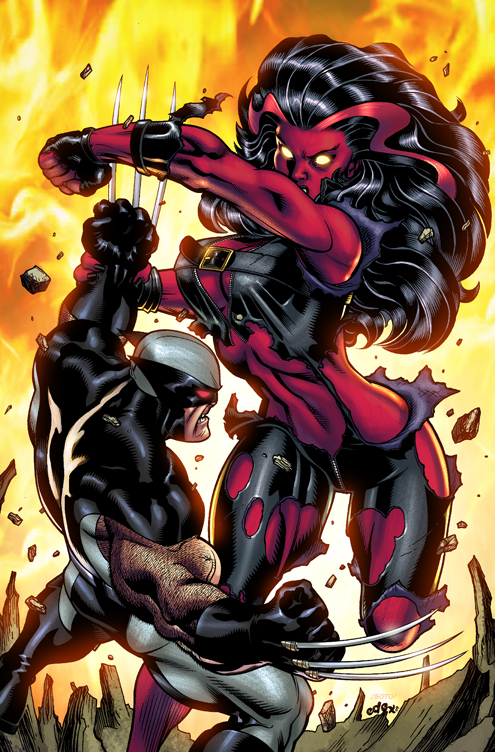
HULK #17
Writer: Jeph Loeb Art: Ian Churchill Publisher: Marvel Comics Reviewer: Mr. Pasty
How do you make the bad guy turn good? Easy, just make the other bad guys double-cross him. It works in movies, the WWE and of course comics. So how come I fell for it so easily? A few issues back I was panning the Loeb compass for pointing myself and the rest of the Hulk faithful in the wrong direction. His arrogant, loudmouthed Red Hulk (Rulk) was like a muscular sideshow barker that couldn’t sell a single bottle of snake oil. Of course the driving force behind this series is the big secret behind Rulk’s identity. Well, for a while there, I stopped caring about who was inside that ruby-red blowhard. I half-expected Daphne and Velma to rip his mask off at some point and exclaim “It’s old man Jenkins!”Fortunately the CODE RED series has not only reversed my position, but practically redefined the series as a whole. Now, I’ve heard the sheep proclaim that RED HULK was written brilliantly all along, but I don’t buy it. What I do buy is that Loeb has been working us over from day one. There were times where I suspected him of making things up as he went along. Now I see that Rulk was obnoxious by design, prompting his eventual face-turn to be that much more significant. Or maybe he just sucked the whole time and the powers-that-be said “Make this guy work or hang up your pencil,” but hey, I’m giving Loeb the benefit of the doubt here.
There was something charming about the simplicity of the “Hulk smash!” approach to the greenskin of yesteryear. It didn’t matter if it hurt his case more than it helped it, because he didn’t have a hidden agenda. When in doubt, knock it out. Rulk tried a similar approach (and why shouldn’t he, since he basically stole everything else from the Hulk), but it blew up in his face. Watching him have to swallow his pride and find a cooperative solution is one of the joys of this book. There’s a fair amount of ass-kicking, and as always Ian Churchill draws it from a fanboy’s perspective. The body types tend to be a little more exaggerated than I like, but his command of the scene – be it action or introspect – more than makes up for such a minor gripe.
Also credit Loeb for the never-ending supply of superhero walk-ons. Any rag can prop up a recognizable face and call it a cameo, but Loeb goes out of his way to capture the personalities too. If you didn’t enjoy a certain orange rock being flung from his bed, well, perhaps this is the wrong book for you. Anyone else want to see a rematch from Hulk #350? Yeah, it was done for a cheap pop, but it was still done right. In the end, I think that’s what has helped this series turn the corner. I’m still a little jaded over the whole “secret” angle, but the way Loeb has started to position his players across the board has helped bring both clarity and a sense of direction to the Red Hulk’s adventures. We may or may not agree with the eventual choices he makes regarding Rulk’s identity, but barring an appearance from old man Jenkins, we can at least say we enjoyed the ride.
Final Word: CODE RED has propelled this series into an enjoyable and provoking journey through the world of the Red Hulk and the cast of characters that stand in his way. If you’re still waiting for the identity bomb to drop before you commit, you may miss out on all of the reasons it was such a big secret in the first place.
Web heads who can’t get enough of Mr. Pasty’s word vomit are encouraged to watch him operate as Nostradumbass over at here. MMAmania.com. Love, hate and Mafia Wars requests should be directed here.
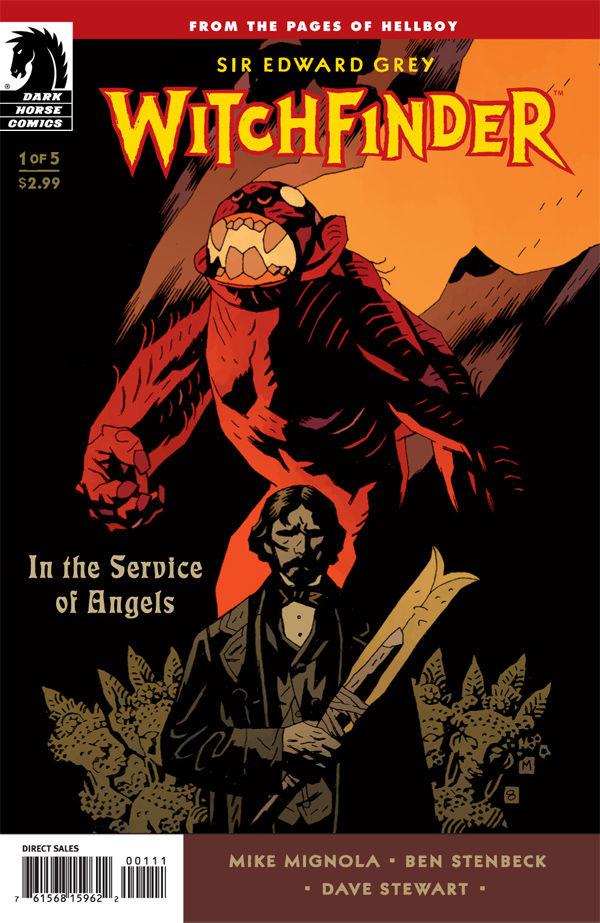
SIR EDWARD GREY: WITCHFINDER – IN THE SERVICE OF ANGELS #1-5
Writer: Mike Mignola Art: Ben Stenbeck Publisher: Dark Horse Reviewer: Ambush Bug
I have to admit that my initial interest in this book was entirely selfish. Although I love the movies and can understand the appeal of the HELLBOY books, I never really got into them. Not because those types of stories of pulp adventure and Lovecraftian horror didn’t appeal to me. It was because when the first issues of HELLBOY came out, I was suffering from new universe overload, what with Image, Valiant, Defiant, Impact, Malibu’s Ultraverse, and Dark Horse’s own super hero line cluttering up the shelves, HELLBOY simply got lost in the shuffle for me.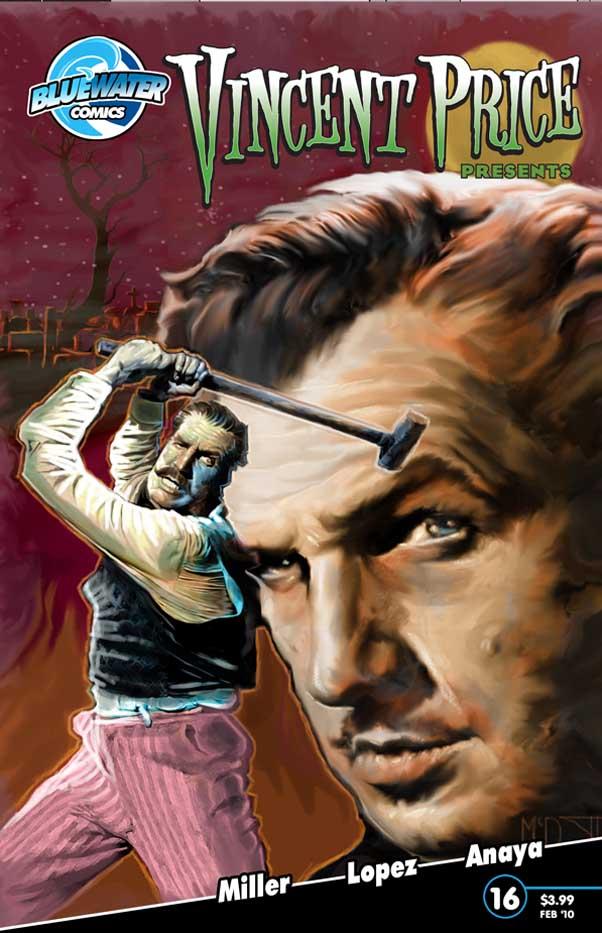 But like I said, the reason my interest was piqued when I first saw this book announced was because I have a comic of my own coming out in a few months based on Vincent Price’s iconic role of WITCHFINDER GENERAL (also known as THE CONQUEROR WORM when it was released in America) in the upcoming VINCENT PRICE PRESENTS #16. When I saw the title WITCHFINDER and Mike Mignola’s name attached into it, I swore out loud in my comic store knowing that whatever WITCHFINDER story I would write wouldn’t be worthy enough to hold the jockstrap of whatever Mignola had to offer.
But like I said, the reason my interest was piqued when I first saw this book announced was because I have a comic of my own coming out in a few months based on Vincent Price’s iconic role of WITCHFINDER GENERAL (also known as THE CONQUEROR WORM when it was released in America) in the upcoming VINCENT PRICE PRESENTS #16. When I saw the title WITCHFINDER and Mike Mignola’s name attached into it, I swore out loud in my comic store knowing that whatever WITCHFINDER story I would write wouldn’t be worthy enough to hold the jockstrap of whatever Mignola had to offer.So when I saw the book on the shelves, I had to take a look at it simply to see if this miniseries and my story shared any similarities. Thankfully, Mignola’s story of a witch hunter set in the late 1800’s bore no resemblance to my story. I’m not talking quality here. I’m talking plot. Thankfully again, the story was a damn fine read too.
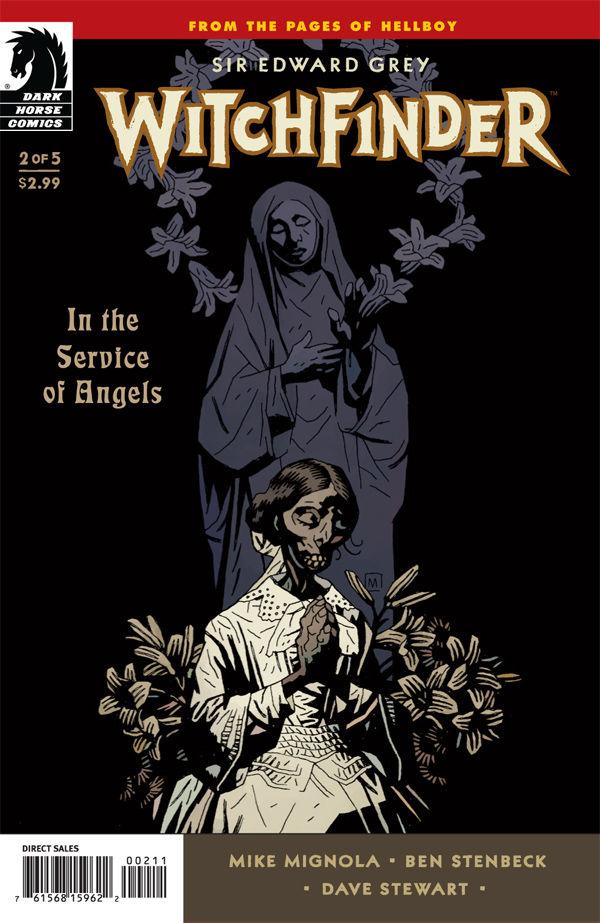 Though I hadn’t read Sir Edward Grey’s previous appearances and adventures in the HELLBOY books, I had no trouble catching up with Mignola’s fascinating character. Just as one would be able to pick up a Sherlock Holmes mystery out of sequence and still understand the whodunit, Grey’s previous appearances seem as if they could be enjoyed on their own. I’m sure it would enrich this reading experience, but even without prior knowledge of the character, I was able to follow along.
Though I hadn’t read Sir Edward Grey’s previous appearances and adventures in the HELLBOY books, I had no trouble catching up with Mignola’s fascinating character. Just as one would be able to pick up a Sherlock Holmes mystery out of sequence and still understand the whodunit, Grey’s previous appearances seem as if they could be enjoyed on their own. I’m sure it would enrich this reading experience, but even without prior knowledge of the character, I was able to follow along.Though it is made apparent through conversation that Grey has hunted witches in the past, this miniseries takes the newly knighted avenger on an adventure facing monsters of all sorts. More of a Monsterfinder than a Witchfinder, Mognola has crafted a peculiar character as lead. Modest, eccentric, and misunderstood by most, Grey is the type of character one can easily imagine Johnny Depp playing since much of the character’s emotion come off as awkward and somewhat subdued. As Grey stumbles through this mystery, he seems more at home with the occult and the weird than with normal folk. Grey himself is often looked at as an outsider here, which heightens the irony of the character and Mignola’s deft way of handling these complexities.
 The mystery itself is pretty fantastic and the stuff great pulps are made of. There’s a lot of history at play here, with Grey stumbling upon parts of the story throughout the narrative. Mignola is stingy with the details at first, telling the reader about an expedition lead by a group of scientists proven fruitful when they come across the skeleton of what looks to be the missing link between man and beast. Though members of the scientific party begin to drop like flies, the survivors bring the bones back to London. When only a few of the surveyors are left, they finally get it that the bones are cursed and try to get rid of them. Grey comes into the story late in the game, as he investigates the grisly murder of one of the last scientists. Piecing the mystery together, he encounters some kind of Neanderthal vampire ghost, a beast which is only deterred by an ancient Sumatran wand.
The mystery itself is pretty fantastic and the stuff great pulps are made of. There’s a lot of history at play here, with Grey stumbling upon parts of the story throughout the narrative. Mignola is stingy with the details at first, telling the reader about an expedition lead by a group of scientists proven fruitful when they come across the skeleton of what looks to be the missing link between man and beast. Though members of the scientific party begin to drop like flies, the survivors bring the bones back to London. When only a few of the surveyors are left, they finally get it that the bones are cursed and try to get rid of them. Grey comes into the story late in the game, as he investigates the grisly murder of one of the last scientists. Piecing the mystery together, he encounters some kind of Neanderthal vampire ghost, a beast which is only deterred by an ancient Sumatran wand.What commences is a good old fashioned outsider detective story as Grey faces challenges of both the occult flavor and the disgruntled frowns of his non-believer colleagues in the police force. Mignola repeatedly highlights Grey’s role as outsider in this miniseries. Like Marvel’s merry mutants, he’s protecting a world that hates and fears him. It’s a role ripe with potential and fitting for a man whose very profession is something most don’t believe in.
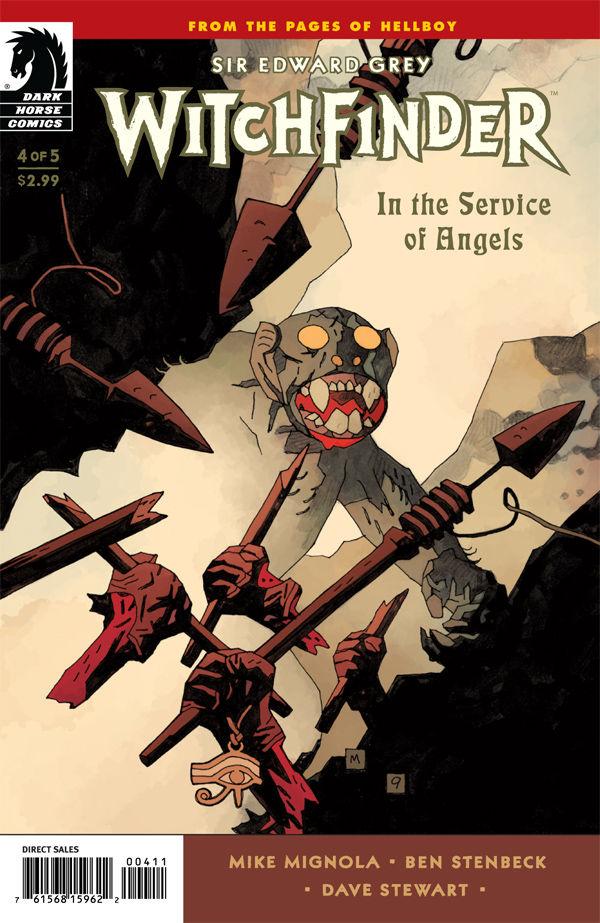 Mignola borrows from many literary and factual stories to put together this mystery. Not only does it seem like Mignola did a lot of research into conspiracy theories of old, he also homages such mystery milestones as THE MURDERS IN THE RUE MORGUE with the ape-like beast and the murders occurring in a locked room. All form of beasties and weird happenings occur in this one. You’ve got the aforementioned ghost beast, a medium who projects an astral ghost form, a church full of corpses, and a wizard stuck in an asylum all peppered with Mignola’s sense of gorgeously wicked design and personality. It really is a memorable story worth reading and rereading and one that would make a great film in itself.
Mignola borrows from many literary and factual stories to put together this mystery. Not only does it seem like Mignola did a lot of research into conspiracy theories of old, he also homages such mystery milestones as THE MURDERS IN THE RUE MORGUE with the ape-like beast and the murders occurring in a locked room. All form of beasties and weird happenings occur in this one. You’ve got the aforementioned ghost beast, a medium who projects an astral ghost form, a church full of corpses, and a wizard stuck in an asylum all peppered with Mignola’s sense of gorgeously wicked design and personality. It really is a memorable story worth reading and rereading and one that would make a great film in itself.Though the cover designs are fantastically all Mignola, the interior images belong to Ben Stenbeck who does a worthy job of aping Mignola’s style while adding his own unique stamp to it as well. Stenbeck’s action sequences occasionally miss their mark with some of the poses he has the ape/ghost beasty perform coming off as somewhat awkward, but Stenbeck knows how to convey an iconic panel and does so numerous times throughout this miniseries. You can tell Mignola designed the creatures in this story what with the simplistic details of their features. This mini is a fantastic showcase of Stenbeck’s talent and I hope to see more of him in the future.
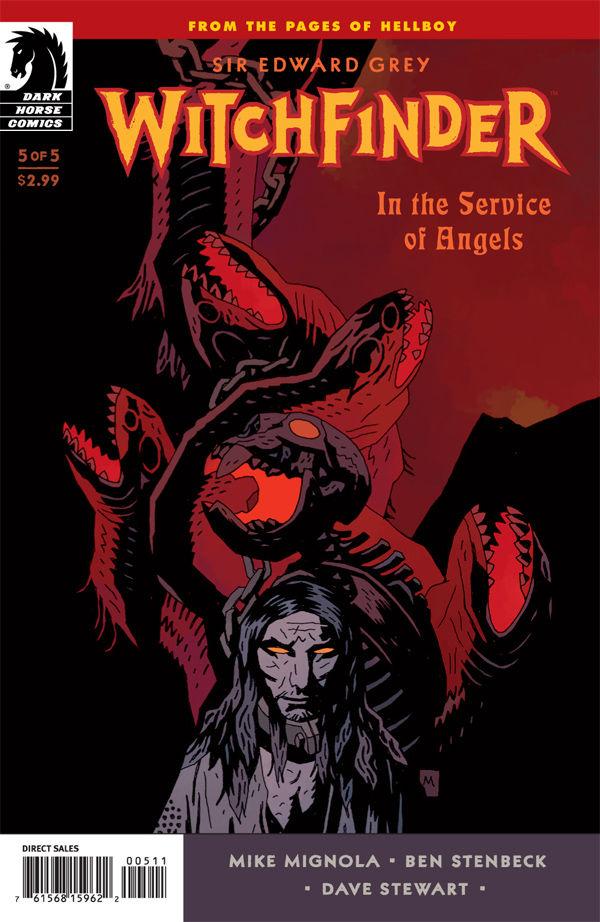 Though my intentions were egotistical going into this miniseries, I’m happy to say that apart from some peace of mind that my Witchfinder story is very different from Mignola’s masterpiece, SIR EDWARD GREY: WITCHFINDER is also a thrilling occult mystery like few others I’ve read. Having no prior knowledge of the character, I found myself eager to seek out further adventures of Sir Edward Grey and the wicked world he defends evil from on a daily basis. Mignola ends this series ominously with a promise of the evil doings from a secret society and Grey’s further struggles to thwart them. Hopefully these stories will be told and I’ll get to enjoy more from this finder of witches and all things that go bump in the night. All five issues are out now, but a glance at Dark Horse’s website let me know that a trade will be out very soon, so you might want to wait for that to pick up this fantastic tale.
Though my intentions were egotistical going into this miniseries, I’m happy to say that apart from some peace of mind that my Witchfinder story is very different from Mignola’s masterpiece, SIR EDWARD GREY: WITCHFINDER is also a thrilling occult mystery like few others I’ve read. Having no prior knowledge of the character, I found myself eager to seek out further adventures of Sir Edward Grey and the wicked world he defends evil from on a daily basis. Mignola ends this series ominously with a promise of the evil doings from a secret society and Grey’s further struggles to thwart them. Hopefully these stories will be told and I’ll get to enjoy more from this finder of witches and all things that go bump in the night. All five issues are out now, but a glance at Dark Horse’s website let me know that a trade will be out very soon, so you might want to wait for that to pick up this fantastic tale.Ambush Bug is Mark L. Miller, reviewer and co-editor of AICN Comics for over eight years and one of the original @$$holes. Check out his comic book shorts from Cream City Comics’ MUSCLES & FIGHTS VOL.3 and MUSCLES & FRIGHTS VOL.1 on his ComicSpace page. Bug was interviewed here and here at Cream City Comics and here and here about his latest comic from Bluewater Comics, VINCENT PRICE PRESENTS: THE TINGLER #1-2. Look for more comics from Bug in 2010 from Bluewater, including VINCENT PRICE PRESENTS WITCHFINDER GENERAL, ROGER CORMAN PRESENTS DEATHSPORT, and the just announced vampire miniseries NANNY & HANK (and check out Jazma Online’s new interview with Bug about NANNY & HANK here).

LENORE: NOOGIES – REMASTERED EDITION
Writer: Roman Dirge Artist: Roman Dirge Publisher: Titan Books Reviewer: Matt Adler
I’m fairly new to Lenore’s world, so I hadn’t read these original stories. This book contains the first four issues of Lenore’s series, this time in color. In the introduction, creator Roman Dirge explains the travails he went through to bring this remastered edition to life. His own digital copies of the original art (some of it begun as long as 17 years ago) were lost, and previous publisher Slave Labor Graphics’ offices had been destroyed by a drunk driver, so their copies were gone as well. As such, he had to work from scans of the comics, which necessitated him painstakingly restoring the artwork by hand and coloring it himself in the process. This is the kind of dedication to one’s work that makes a work more compelling; it shows in the final product when the artist cares that much.Dirge also explains that he’d wanted to do Lenore in color from the start, but simply didn’t have the resources. Some may be wary when an artist revises their earlier work “the way they’d always intended” (think of George Lucas) but the changes here aren’t too drastic, and it doesn’t come across as someone embarrassed by the rawness of their earlier work, or looking to “clean it up” and remove all the little quirks that made it memorable in the first place.
In fact, the rawness is all here to see, and it’s very interesting to compare it to the latest LENORE volume. Lenore hasn’t changed THAT much in all this time; her adventures still pretty much consist of random acts of lunacy. Yet in the most recent volume, there is some sense of Lenore and her cohorts having solidified as characters, and there is something of a narrative to the story. These early shorts have not yet reached that point; here, Lenore is character that can essentially be dropped into any scenario, regardless of where she was or who she was with the last time we saw her. There’s a certain freedom to that, in that at this point, she’s really not bound by any kind of continuity constraints.
And it allows for what feels like an even more personal work; in these early years, Dirge is able to do pretty much with Lenore whatever tickles his fancy, rather than being concerned at all with what readers expect from the character. Those familiar with Dirge’s work will know that what tickles his fancy the most is taking the innocent and sweet for a sudden and violent turn into the horrifying, albeit played for laughs. This is highlighted best in a number of twists on classic nursery rhymes featuring Lenore, including “The Itsy Bitsy Spider” and “Little Bunny Foo Foo” (Lenore has a fondness for all God’s creatures).
The features that are most developed, in terms of what the book will eventually become, are those featuring Ragamuffin, the vampire rag doll, and a brief “origin of Lenore” strip (which is expanded on in the latest volume). There are also a few of Dirge’s autobiographical “Things Involving Me” strips. Some of it is very revealing and painful, though still done with Dirge’s wry sense of humor. Finally, several artists including Jhonen Vasquez and Ted Naifeh offer up their own take on Lenore in a guest art gallery. I have to say, I was very impressed with the amount of work which is evident in having gone into making this volume. A very solid package.
In most places, Matt Adler goes by the name his mother gave him, but occasionally uses the handle "CylverSaber", based on a character he created for the old DARK FORCES II: JEDI KNIGHT game (one hint of his overweening nerddom). He currently does IT and networking support for the government of Nassau County, NY, but his dream is to write for a living, and is in the process of figuring out how to get publishers to give his stuff a look. In the meantime, he passes the time by writing for AICN, CBR, and a few other places. He has also written for MARVEL SPOTLIGHT magazine.
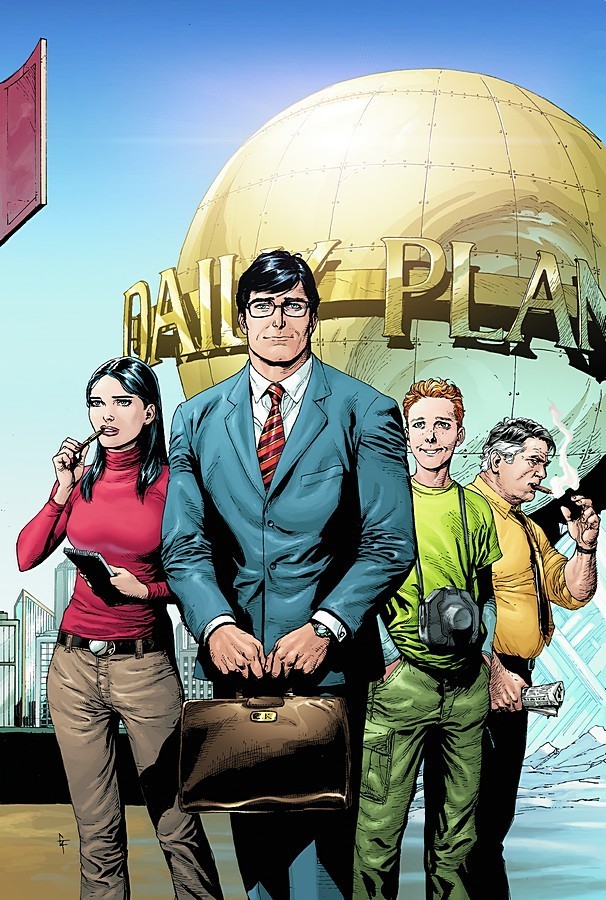
SUPERMAN: SECRET ORIGINS #3
Writer: Geoff Johns Artist: Gary Frank Publisher: DC Comics Reviewer: Optimous Douche
For anyone that believes the best stuff at DC right now is solely shrouded in the darkness of BLACKEST NIGHT; I pull out my white glove, slap you in the face with it and say, “poppycock to you sir.” Because while BLACKEST NIGHT has been an exhilarating intergalactic adventure, where I am finding my fanboy nipples tweaked at the moment is right here on terra firma with BATMAN & ROBIN and now SUPERMAN: SECRET ORIGINS. Basically BLACKEST NIGHT is not a surprise; even Johns’ detractors knew there would be some nuggets of goodness within the pages of BLACKEST NIGHT, but I think it’s safe to say that no one, even Geoff Johns zealots, were expecting good things from SECRET ORIGINS.I was certainly one of the skeptics, despite the fact I loved every page of the last Johns/Frank team up during the birth of New Krypton. After all, that was at least moving the Superman mythos forward, while SECRET ORIGINS is a giant step back to square one that has been done time and time again (quite recently in fact within the pages of ALL STAR SUPERMAN). At the end of the day what really needs to be said that hasn’t already come across in the thousands of SUPERMAN books over the past 70 plus years? Well, whoever said “the devil is in the details” had obviously never read a book by Johns, because the details are where his stories come alive and veer sharply away from being derivative or unoriginal.
Unlike the first two issues of this series that explored the lesser known (to some) origin of Superboy and his relationship with The Legion of Superheroes, the events of issue three will resonate with comic and non-comic fans alike. This is Clark’s first day in Metropolis and the first day he walks into the hallowed halls of the Daily Planet. However, this is unlike any Daily Planet we have seen prior. Johns fearlessly places the grand ole gal in the same dire straits as newspapers in the real world. Dwindling sales and a general lack of public respect means the reporters actually have to work to get their stories, instead of reporting celebrities that can do as they please. This is important set-up for the fateful unveiling of Superman.
Even if you couldn’t tell a Cat Grant from a Lois Lane before this issue, Johns breezily conveys everyone’s role and purpose in the Superman world in a few pages. With merely a look you know that Cat Grant is looking to get a few claw marks down Clark’s back. Steve Lombard’s bravado and douchiness ooze off the page with the way he dismisses Jimmy Olsen and Perry White is still a bit of a curmudgeon, but gone is the swagger that came with being the editor of the top paper in Metropolis. Even the ancillary characters aid in updating this famous scene for modern times. Before Clark enters the newsroom he is taken for his lunch and a few dollars from the maintenance man who weaves Clark a false tale of woes to take advantage of Clark’s obvious good nature.
Then there’s Lois; even if Johns had bumbled the other characters (which he didn’t) or simply chose to ignore them, Lois is the one character I would say even beyond Lex Luthor that must be done right. Lois needs to be confident and assured; in past iterations of the character this made Lois come across as kind of a bitchy or pretty much made her a man in a skirt (or pantsuit — see Margot kidder for proof). I won’t fault these past iterations because they were reflective of the times. Just twenty years ago a woman had to forego her sexuality to be taken seriously in a man’s world. Thanks to those efforts, today’s women can show their inherent softer side while still showing they can play it rough and gruff when warranted. Johns will receive a certain amount of flack for this softening, like taking Clark under her wing for example. This does slightly change the dynamic of him perpetually chasing after her, but where some reviewers see this as a complete destruction of canon I see it as yet one more opportunity to update the mythos. Clark will still have to chase Lois; it doesn’t mean she needs to constantly look at him like he was something she scraped off the bottom of her shoe. There’s also a great throwaway line where Lois names this new partnership after a certain TV series that ran on ABC in the early 90s.
We don’t see Lex in this issue, but his presence is everywhere in Metropolis. Lois and Clark’s first adventure involves breaking into LexCorp for a press conference about his latest exoskeleton marvel – Metallo. This was probably the one part of the issue where I was taken away from the action for a minute since the rescue of Lois, which ultimately introduces Superman to the world, involved – a helicopter. While Johns certainly put a different spin on this encounter, this is the one scene where I think he could have broken from the grasp of Richard Donner.
Normally I finish off my reviews by focusing on the art. Really there’s no need here. Gary Frank’s work is exquisite. To all of the haters that keep bitching about Frank invoking the vestige of Christopher Reeve, I have to ask why? Christopher Reeve was chosen for the role because he was the man-pretty version of all the men that had occupied the suit prior. If you want to bitch, bitch if Frank drew Superman like Dean Cain. Superman is not Asian.
So instead of finishing off with art, let’s finish off by answering the big question, “Does Superman’s origin deserve or warrant a retelling?” To answer this, I will invoke a little movie from a few years ago called SUPERMAN RETURNS. While certainly not a box office disaster, the movie did fall short on many expectations. Probably the most egregious mistake was catering the plot to a certain demographic, namely those that had knowledge of the original movie thirty years prior. The movie also stumbled in forcing a new generation of characters to inhabit the sensibilities of the prior generation. Times and mores change with each generation, and with that canon should also be rewritten to keep tried and true archetypes alive.
When Optimous Douche isn’t reading comics and misspelling the names of 80’s icons, he “transforms” into a corporate communications guru. "What if the whole world had superpowers? Find out in the pages of Optimous’ original book AVERAGE JOE. Read the first full issue on Optimous’ New Blog and see original sketches by fellow @$$hole Bottleimp. If you are a publisher or can help these guys get AVERAGE JOE up, up, and on the shelves in any way, drop Optimous a line."
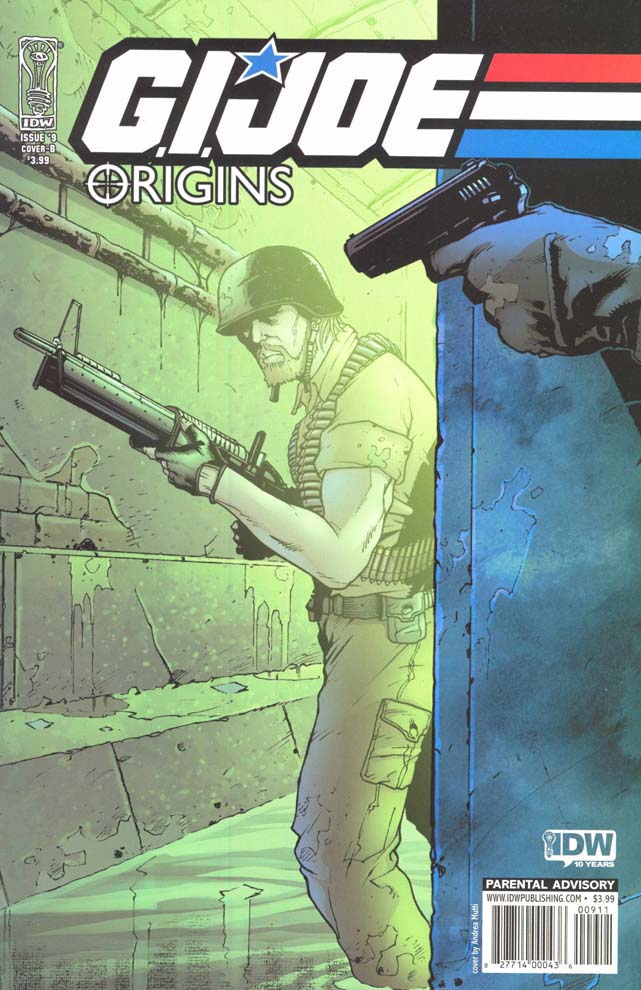
GI JOE: ORIGINS #9
Writer: Larry Hama Art: Andrea Mutti Publisher: IDW Publishing Reviewer: Mr. Pasty
If any series warrants the “origins” treatment, it has to be GI JOE. There have been so many unexplored storylines and colorful characters spread across the past twenty-five years that this series could practically write itself. If only. I was really looking forward to this new direction the minute I heard Larry Hama was bringing his pencil back to Joe headquarters. For my money, the success of GI Joe in the 1980’s was a result of Hama’s ability to inject his personal experiences and military knowledge into the franchise. The result was not just a realistic and exciting product, but one that felt more like a war diary and less like ‘Archie joins the Army.’ I was expecting more of the same when Hama returned. Then again, I was also expecting more ‘Empire’ when George Lucas returned to the Star Wars saga in 1997.That’s not to suggest that a baby Destro is pod racing his way through puberty, but there isn’t much here to distinguish this line from any other military outfit chasing their enemies across the globe. I suppose this book then is much like the recent GI Joe movie. There is nothing about Channing Tatum that even remotely embodies the character of Duke other than the fact that people refer to him that way. Nor is there anything in this comic that feels like it was birthed by the Joe universe. A.I.M.? HYDRA? S.H.I.E.L.D.? Why not? ORIGINS could very easily be a story about any one of them with a few name changes. Again, you come to expect a certain tone, perhaps even a certain attitude from a franchise that not only brings back the characters you love, but also one of the talents that gave you a reason to love them. I just can’t fathom how a writer like Hama, who was so brilliant in THE ‘NAM (and of course GI JOE) could churn out such an uninspired comic book.
It’s not that ORIGINS is offensively bad, it’s just kind of “there.” The Joes are chasing some bad guys across Paris trying to uncover their grand scheme. Some name-dropping takes place and Snake Eyes broods his way through a couple of panels. Everyone has a hip hairdo. Okay, check. And then BAM! Destro came crashing through the walls of GI Joe headquarters in a HISS Tank and opened fire on an unsuspecting Lady Jaye! Well, not really, but it sure would have been nice. I kept waiting for a climax like that to come and it never did. In fact, as I’m writing this, I can’t even remember how it ends – and I read it three times. Okay, I just looked. Duke mentions something about a turkey shoot.
This book could have probably been saved with a memorable artist. I say “probably” because this one happens to be vandalized by Andrea Mutti, who not only fails to save the blasé approach to the origins of GI Joe, but damn near dooms the entire book from page one with her drab palette and clumsy character design. The easiest way to describe it is to imagine Keanu Reeves as ‘Taylor’ from PLANET OF THE APES (Dude, like seriously, get your stinkin’ paws off me). Everyone runs around in Seattle grunge mode, looking cool and darting in and out of shadows. Snake Eyes’ big appearance in the end is worthy of an entire page – but not worthy enough to avoid being drawn like a transsexual beekeeper.
I was excited about reconnecting with the Joe universe I know and love. Even more so when I heard that Larry Hama was back in the saddle again. Unfortunately this is far from his best work. I will say this comic was good enough to get me thinking – thinking about how much I miss the old days of Larry Hama and GI Joe.
Final word: GI JOE ORIGINS #9 is a paint-by-numbers approach to the origins of your favorite Joe characters. Had I known their ascension to the top of the military food chain was so tepid, I might have passed on the opportunity to see it in greater detail.
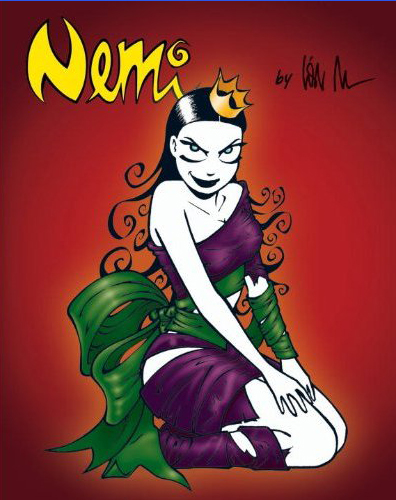
NEMI III
Written and Illustrated by: Lise Myhre Published by: Titan Books Reviewed by: superhero
It’s an unfortunate truth that whenever I’ve come across a comic strip by a female creator that involves dealing with the trials of the single girl my mind immediately jumps to thinking about the classic yet annoying CATHY. Anyone who ever read a newspaper comic strip back in the day can remember CATHY and, if you were male and heterosexual, how incredibly aggravating she was. CATHY, as far as I’m concerned, was the bane of the old newspaper strips and along with THE FAMILY CIRCUS made my jaunt over the comics section of my local paper to find CALVIN AND HOBBES and BLOOM COUNTY more irritating than it should have been. Sorry ladies…but that shit wasn’t funny. I get that I wasn’t the target audience but dammit I hated CATHY.So it’s very fortunate for me that NEMI is not CATHY. NEMI shares some of CATHY’S traits, for sure. There’s a lot of frustration of the single girl humor in the pages of this book but in NEMI’S case most of the stuff made me smile as opposed to cringe. Again, I’m obviously not the target audience for this type of book but I actually have to say that I liked it more than I thought I was going to. Maybe it’s because I always liked goth chicks growing up. Hell, maybe it’s because I married a former goth chick. But more likely it’s because the work in this book is very professionally done and, yes, actually quite funny. The artwork and coloring are deceptively simple yet there’s an energy that Myre injects into the pages that makes the panels and character pop. I’ll be honest, when I first looked at this book I was very dismissive toward it. I was not going to read it. But, lo and behold, I decided to leaf through the first couple of strips and I got hooked. NEMI would not be denied.
So, if you’re interested in the opinion of a married, thirtysomething male when it comes to a comic about a goth girl’s tribulations in life here’s mine: NEMI is some good clean fun with an edge to it. I enjoyed it. I’ll recommend it to some of my female friends to read because I probably think they might enjoy it. But, best of all, the greatest thing I can say about it is it’s not CATHY. And that’s saying a lot. It’d make a great stocking stuffer for the goth or not so goth girl in your life.
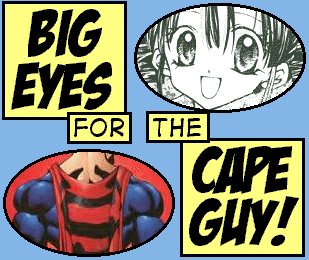
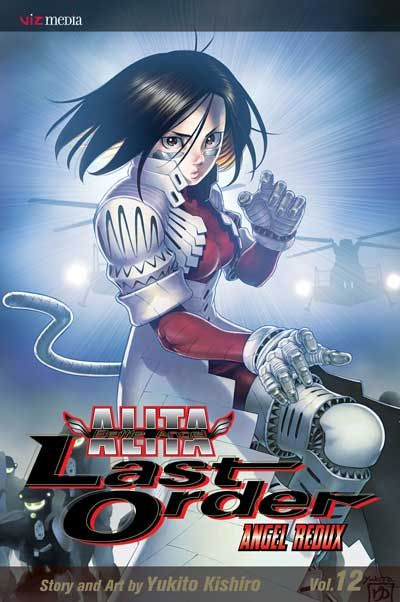
BATTLE ANGEL ALITA: LAST ORDER Vol. 12: ANGEL REDUX
By Yukito Kishiro Released by VIZ Media Reviewer: Scott Green
Volume 12 of LAST ORDER doesn't feature an invention that can match 11's Anomaly. Then again, Yukito Kishiro does present a half page chart laying out the "Birth and Evolution of Karate" from the 17th century to the collapse of civilization due to meteor impact, then, following a break in history, from the birth of the space age to BATTLE ANGEL ALITA's present. This info graphic sets the stage for a battle royale between the branches of the martial art, as combatants jockey for a spot along side block faced and traditional gi clad master of Electromagnetic Space Karate Toji and rowdy biker Zekka on the Space Karate team. So, for a chapter that will bring a smirk to the face of any geek, the likes of Robbie from the Robo Karate school, Grasshoppa from the Rider Karate school and Chupacabra from the Vampire Karate school square off.The original BATTLE ANGEL offered more cause to be invested in its characters. You cared about the directions that their lives took and were curious about how Kishiro would adapt or develop his style to take them there. That's not in the offering for LAST ORDER.
Volume 12 has a scene in which a Versailles-esque noble from the Republique Venus turns up with a biogeneered clone of a particular character. The hermetically emblazoned Biovouivre rep unfurls a Hieronymus Bosch-esque tableau of a man dressed in clothes biogeneered from this character, on a chair biogeeneered from the individual, at a table... eating meat...accompanied by a dog all incongruously shaped from the person. This is an apt metaphor for what Kishiro himself is doing in LAST ORDER: breeding together ideas that would seem unlikely to find themselves in the same contextual habitat and having those ideas duke it out. It's the same trick again and again with one oddity replacing another in the kinetic, finely detailed fight illustrations.
Unlike the character odyssey of the original, nine volume BATTLE ANGEL ALITA, its sequel, LAST ORDER, took a few volumes to lock into the fighting tournament formula. The concept utilized here, seen in many of the most popular shonen manga series from DRAGON BALL to NARUTO to ONE PIECE, is that a team of protagonists faces off against an escalating hierarchy of opponents. Especially in their current form, these stories generally jump onto tangential narratives to explore the histories and motivations of the swelling ranks of allies and opponents. The attraction to writers and editors of boys' manga is obvious. It gives the hero's fighting a purpose. With the reader able to see who will be fighting who in future installments, there's a readily available hook. And, by iterating on the tournament bracketing, the manga in question can repeat the pattern as long as the titles popularity hold's up. Any story formula that can be used as the engine for a serial that can last years, or even decades, is liable to possess a tendency to become tedious. And, if any genre is indictable for loitering in an easy loop, fight tournament stories are a repeat offender.
LAST ORDER has been running since 2001, and still seems closer to a midpoint than an end of the current tournament arc, with plenty of doors open to continue the manga after the maybe misleadingly named Zenith of Things Tournament (Z.O.T.T.) wraps. It might even shift its framework the way the earlier manga series.
In this volume, Alita has upgraded her physical presence with a new the new overcoat and cat-tail adorned Imaginos 2.0 body, and she has a mid-ring stare down with LAST ORDER's uber-heel, yoga/Kalarippayattu - Buck Rogers gone pathological Aga Mbadi.
If this were the original BATTLE ANGEL ALITA and the heroine were eyeball to eyeball, in the range to physically strike her greatest foe, there would be emotional resonance. In a manga series that is narratively inching along, volume 12 constitutes a move up a rung of the tournament ladder, and as such features a step forward. The Aga Mbadi meeting is the equivalent of two combat sport fighters exchanging threats in anticipating of meeting in a few fights. In order word, an act of promotion.
While this could be a dire way to run a manga series, Kishiro embraces it with frothing zealousness. His talent for fleet-footed complexity applies to the ideas utilized in LAST ORDER. There's no reserve; a foe that could trouble heroes for a chapter is disposed of in a panel, to give way for another, just as ingenious and just as quickly consumed.
And the quality applies to his illustration; in one great sequence of panels Alita crushes her opponent's hand, spins herself 360 and flicks the gristle off her fingers; in another Zekka drains his bottle of "Mothman TNT Beer," holds the mouth between his fingers and shakes the bottle, places it down, puts his palm over it, and using his Space Karate, swats it, leaving a palm impressed disc of glass. Realizing this level of complexity in the first Battle Angel Alita ultimately proved taxing on Kishiro's heath. He simplified the work for the initially rocky but eventually inspired Aqua Knight. Then, when he returned to ALITA for LAST ORDER, a monthly schedule allowed him to pack as much into a chapter as he wanted without hurting himself.
I recently sketched out a list of what I believed to be the best (in terms of artistic merit and significance) manga to be released in North America in the 00 decade. Then I sketched out a list of my favorite manga from the same period. LAST ORDER was firmly in the latter list, and nowhere near the former. Simply, as a manga reading experience, its gleeful pairing of an unrestricted, silver age-like torrent of ideas with the kinetic force of action manga can't be beat.
Scott Green has been writing for AICN ANIME for over eight years. If you like what you see here and love anime & manga, be sure to check out his latest AICN ANIME column every week on AICN.

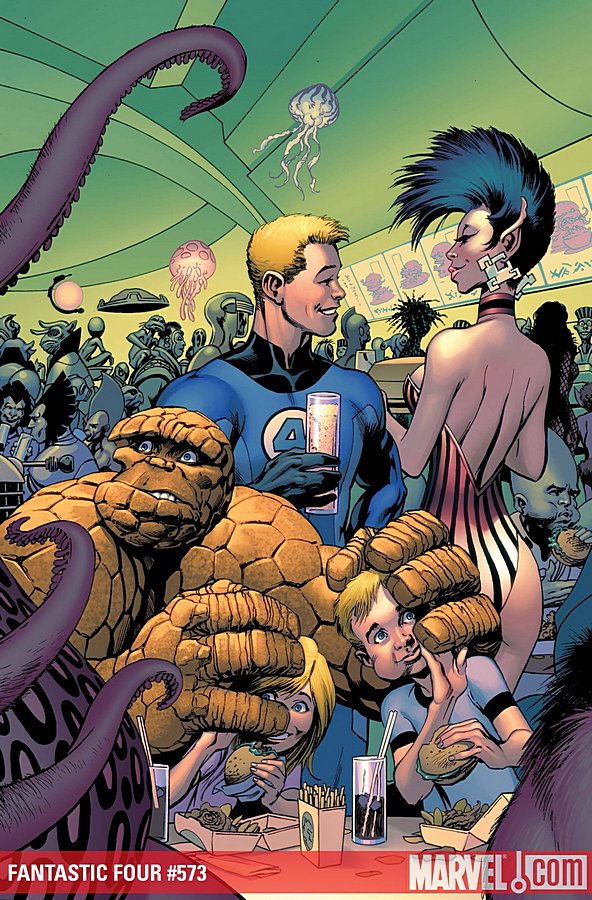
FANTASTIC FOUR #573 Marvel Comics
I'm still digging Hickman's run on FF. His first arc was downright amazing, but this issue is the first blip on the radar that shows that even Hickman can make a misstep here and there. Revisiting NuWorld, which was one of Millar's somewhat interesting ideas from his mildly amusing but relatively fluffy run on the title, Hickman gives Johnny, Ben, and the Fantastic kids a chance to shine here, but the story ends up being somewhat blahs-ville. Everything moves just a bit too fast in this issue for the reader to form some kind of interest. What would normally be a four issue arc seems to be stuffed all into this issue. Had some of the events been fleshed out a bit for even a two-parter, this story may have read a bit more effectively. But in the end, all of the plot points fly by in a flash and left me completely uninvested. Still, Hickman offers some great moments of heart when it comes to how the family interacts with one another, especially with Franklin and Valeria, so it ain't all bad. Looking forward to the next arc. - Bug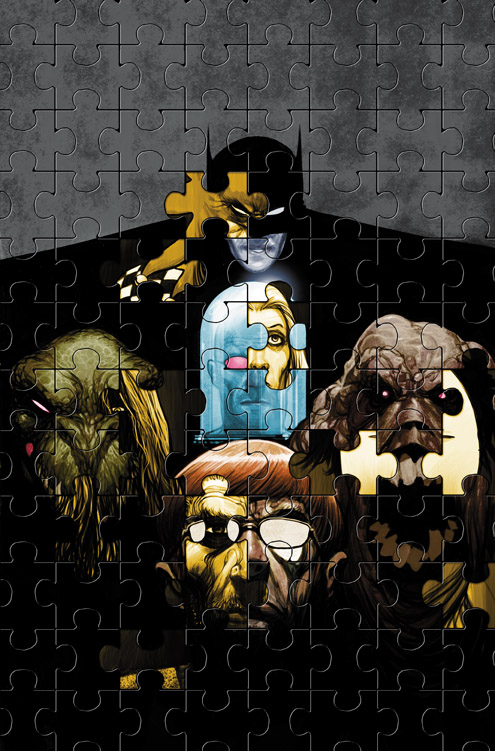
ARKHAM ASYLUM #2 DC Comics
David Hine offers up another winner as he delves into the cracked mind of Dr. Arkham and his inmates. He's laid out a pretty fun mystery here as someone is sabotaging the newly re-opened Arkham Asylum. Is it the eerie daughter of religious fanatics on staff at the Asylum who is making things work less than perfectly? Is it Dr. Arkham's three special patients who are left to live freely in one secret wing of the asylum? Or is it Arkham himself behind all of the funny business? Hine isn't offering up the answers yet, but he is crafting a pretty intense thriller with moments of sheer terror (the Raggedy Man is pretty freaky) and some nail biting action (the stuff with Clayface, Croc, and Freeze is gold). All in all, I've seen a lot of crap Bat-miniseries come and go. This is not one of them. Too bad it’s only three issues. Seems like there's a whole lot more story to tell. Fine storytelling and moody art by Jeremy Haun. - Bug
BOB DYLAN REVISITED OGN W.W. Norton
Not for everyone, but essentially the perfect gift for the Bob Dylan fan on your holiday shopping list, BOB DYLAN REVISITED is a sharp, oversized hardcover package of 13 Dylan songs interpreted by a bevy of talented artists. The art ranges from good to wow, and each artist interprets the songs how they see fit. Each of the 13 songs’ lyrics are typed out before the interpretation, which is helpful for the Dylan uninitiated as some artists use almost all of the lyrics, like a narrative, while others use just a portion, like a chorus. For instance, “Lay Lady Lay” by Jean-Claude Gotting is reduced to two sweet pages of charcoal drawings with five lines of the song in the last panel, while “Positively 4th Street,” by Christopher, gets an eight-page, almost Daniel Clowes-like interpretation of Dylan’s lyrics. There is something to admire in almost all of the vignettes, and some are just knock outs; “Hurricane” is pretty epic, realistic, delicately lined and shaded in black and white, and “Knocking on Heaven’s Door,” by Jean-Philippe Bramanti, is beautifully stylized with Western typography over loose, inked figures and earth-tone washes that mosey you through the song. BOB DYLAN REVISITED is the type of book that the more you think about it, or the more you look at it, the more you like it. Presumably only for the hard-core Dylan fan, it’s also for folks who like a whole lot of pretty art—though the words, of course, are pretty good too. – steverodgers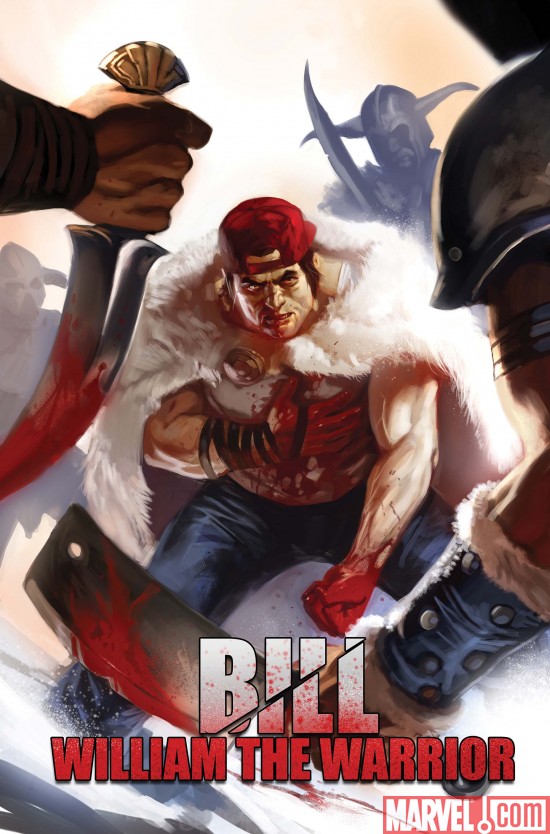
GIANT-SIZE THOR #1 Marvel Comics
So this was JMS' big send off? A pair of fight scenes where Joe Average...err, I mean Bill Average gets his @$$ handed to him by a trio of no-named Asgardians and the Warriors Three, Sif, and Thor battle some Doombots. When the highlight of the issue is Volstagg getting his clothes burned off, you may have a pretty light finale issue. Having Sif stare at Volstagg's enormous unit was somewhat jarring too. I know JMS was busy tweaking the ever so intricate and complex NINJA ASSASSIN script, but you'd think after what a bang up series THOR has been so far, it would have ended with a bit more resonance. And don't let the $3.99 price tag fool you, folks. This is a 22 page story followed by a 10 page preview of the next book and a reprint of Thor's first appearance, once again causing me to say I would rather they drop the filler and pay a dollar less for this. A flimsy end to a phenomenal run on THOR, that's what JMS gave us here. - Bug
THE GOON #33 Dark Horse
It’s a silent GOON issue. Maybe I missed an issue in between, but it seems like ages since I’ve read a GOON book. It’s always fun, always brutally comical; kind of like seeing someone getting hit in the nuts with a whiffle ball bat. In the end, though, this was quite a breezy issue despite the silent treatment with the Goon and Frankie acting more like clichés of themselves rather than doing anything new or original. I guess after some pretty heavy stuff with the CHINATOWN OGN and the most recent multi-part arc, I was used to being a bit fuller after digesting an issue of THE GOON. Powell still shows his gorgeous pencils, inks, and shades get better with each issue, but as far as depth of story goes, the well seems to be running dry. I fear that The Goon may have reached its full potential and serves better as an iconic comic strip like a demented DAGWOOD or SNUFFY SMITH rather than an ongoing comic. I see Powell is venturing outside of the GOON-verse in the ads for this issue for CHIMICHANGA, a story about a bearded girl and her freak show friends. Maybe a bit more time away from the Goon will revitalize this series a bit. It’s always great, but it’s definitely been better. - Bug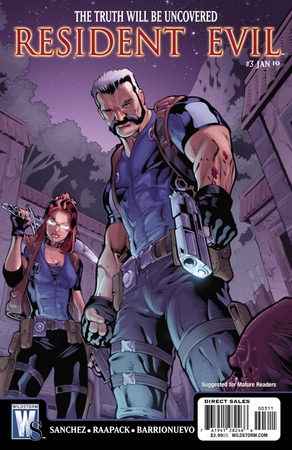
RESIDENT EVIL #3 DC Wildstorm
RESIDENT. EVIL. Anyone who’s played the RE video game knows the chill those two words send down your spine when you press the START button. Unfortunately, that chill is nowhere to be found in the comic book adaptation by Wildstorm. It’s actually drawn quite well -- perhaps a little too bright for the RE universe, but the visuals are delectably Gorno (Pasty-speak for a pornographic depiction of obsessive gore). The writing is sharp and succinct, with dialogue appropriate for a world overrun with blood-sucking corpses. So what’s the problem? Well, for starters, most of us have been desensitized to the living dead ever since they replaced the Nazis as the tried-and-true villain for every story that needed bad guys en masse. Zombies are in dire need of a makeover, because they just aren’t cutting it these days as a reliable foil. I recently praised the revival of the ALIEN franchise over at Darkhorse specifically for showing how the humans reacted to living in a world inhabited by a flesh-eating menace and not just “Aliens gone wild.” If the undead ever hope to make a comeback into relevancy, they may need to adopt a similar approach. More suspense, less offense. RESIDENT EVIL #3 is an animated battlefield pitting humans with guns vs. zombies with teeth. If that’s all you require from your comic books, or you just want to cleanse yourself from some of the more pretentious mainstream titles, you’ll probably really enjoy it. – Mr. Pasty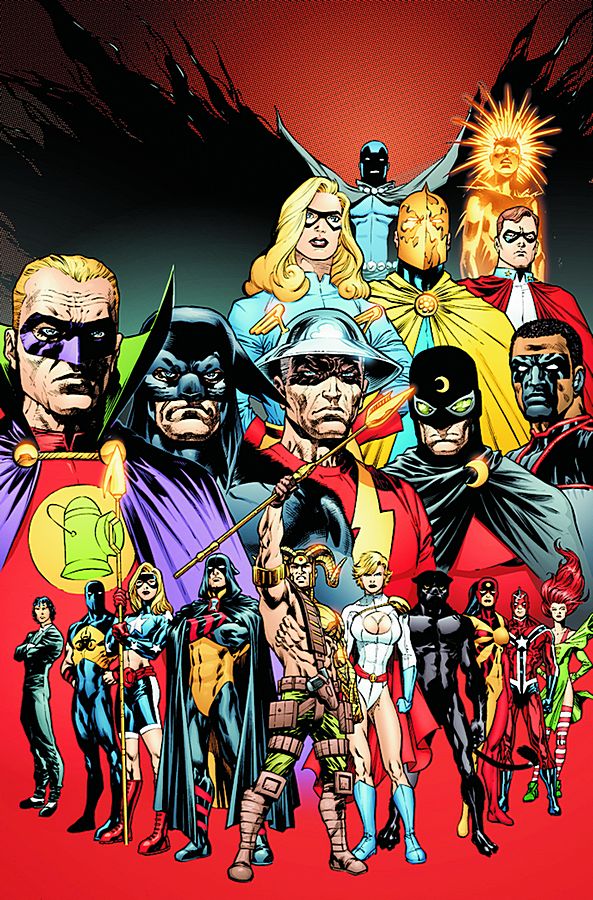
JUSTICE SOCIETY OF AMERICA #33 DC Comics
DC's version of CIVIL WAR occurred here and it ended much more civilly here than with their competitors across the street. I'm not knocking this title because it was really fun to read. Willingham and Sturges have a good handle on all of the different characters. Willingham gives a nod to his SHADOWPACT days. No one knows why none of the villains will touch Stargirl. And in fact, not too many answers are answered here. But this issue is the big break up of the JSA with one team wanting to take a more proactive militaristic approach while another likes the reactionary and traditional route the JSA has been taking. Though the choice of sides each team member chooses feels less forced than what Marvel did with the Avengers in CIVIL WAR, it still felt somewhat disingenuous that standbys like Power Girl, Hourman, and Liberty Belle allied themselves with Magog instead of Alan Scott and Jay Garrick. Still, it will be interesting to see how this pans out. There were too many cast members for one title, so something had to be done, but pitting them against each other just doesn't seem the way to go. I'd much rather see them do an amicable split like what Giffen did with the JLE (maybe a JSE?) or have one fraction train the new generation of heroes and another book focusing on the field team than have them against one another. - Bug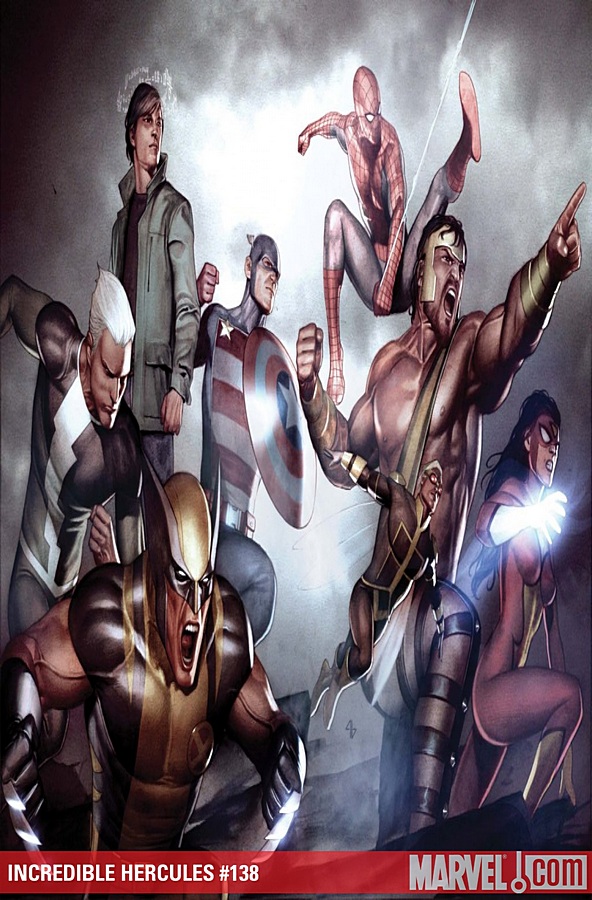
INCREDIBLE HERCULES #138 Marvel Comics
Though this book continues to be some of the most fun you can get in comic book form from Marvel, the fun in this issue was kind of lagging mostly because Cho and Herc seemed like guest stars in their own book when the Mighty Avengers and Spidey and Spider-Woman showed up. Character seemed to take a step aside in favor of action here. Though it’s Cho who comes up with the plan to assault Olympus, the action seemed to center around the Avengers, as if Pak and Van Lente were making a tryout reel for when Bendis gets sick of writing the team. All in all, it was a fun issue with some foreboding promise of cool stuff to come especially in regards to what Athena reveals to Cho early in the issue. I usually prefer singular storylines rather than crossovers or events. I know having guest stars is the nature of the beast in order for a title which may be lagging in sales to gain some readership, but having been a fan of this book from the get go, it serves only as a distraction from the stuff I really like about the book. I'm sure my affinity for this title will once again intensify once the number of guest stars decreases. – Bug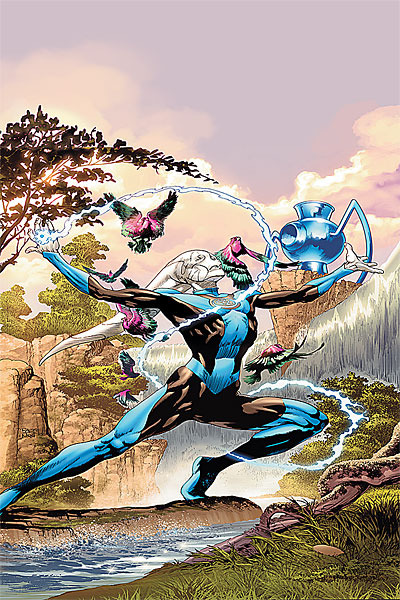
GREEN LANTERN #48 DC Comics
I've been keeping mum about this whole “Blackest Night” event, mostly because it seems to have been in a holding pattern for the last few months, but also because I was looking forward to seeing how Johns was going to get all of these warring colored ring bearers to work together to vanquish the Black Lanterns. In this issue, he does it and the payoff was pretty fantastic. I loved seeing how the bad lanterns were bargaining with one another and forming alliances after this event passes. Agent Orange continues to be a fun foil for everyone. And seeing the history between Sinestro, Star Sapphire, and Hal Jordan play out is always a treat. It's great seeing all of Johns’ hard work play out here. I think once again DC has spread their butter a bit thin with the “Blackest Night” premise spanning all of these crossover titles and basically telling a variant of the same story over and over, but the story shines brightest in this issue. Doug Mahnke continues to be one of the most under appreciated but overly awesome artists out there today. His panels in this book are testament to this. - Bug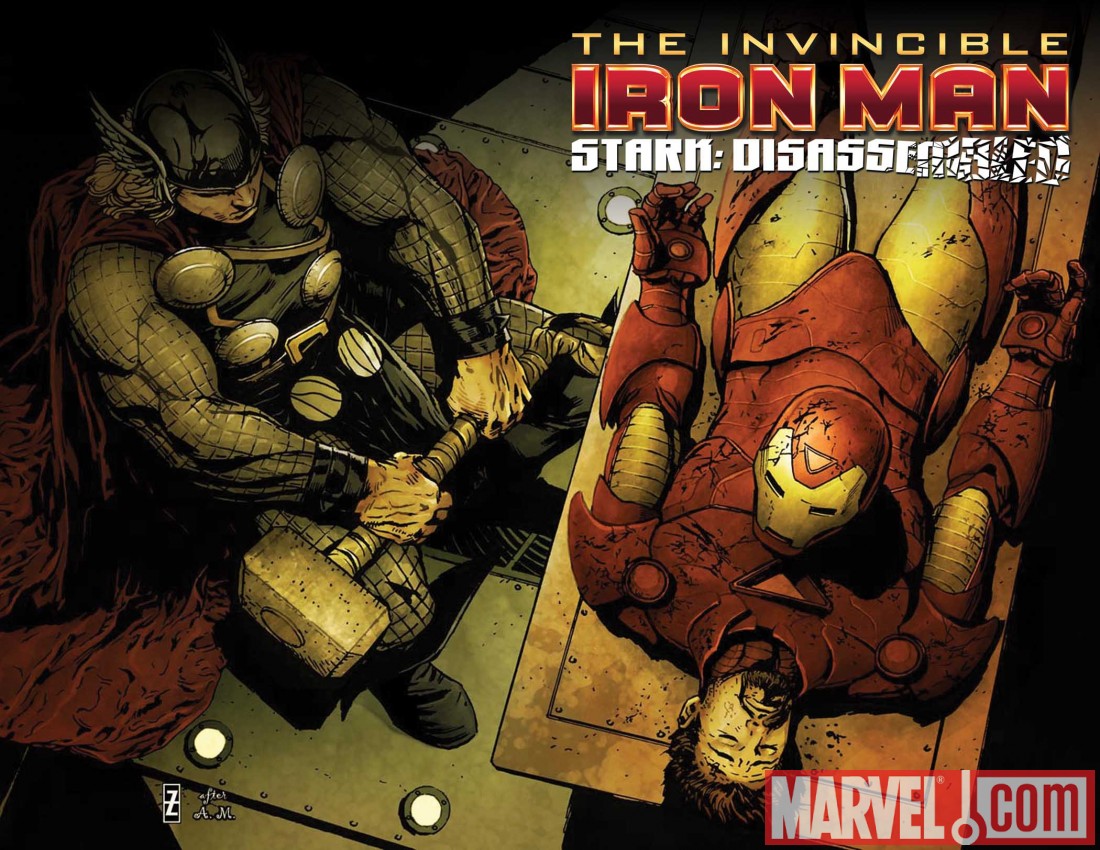
INVINCIBLE IRON MAN #20 Marvel Comics
Matt Fraction has been doing some wide-screened epic stuff with Tony Stark lately and Stark's current predicament seems as dire as they come. This issue, though, read like filler. An extended dream sequence peppered in with a reading of Stark's "will" to Pepper, Maria Stark, Donald Blake, Captain America, and Black Widow when all the ads (and the cover to this issue) promised Thor at the side of Iron Man's bed. Last issue, I saw that cover and I said “I can't wait till this issue!” Now, I'm looking at the next issue double splash page waster and am saying the same thing. Though seeing Thor channel a lightning bolt conducted through Cap's shield connected to Tony's heart seems hokey, it is a damn cool comic booky image and one that gave my fanboy bones a tickle. As with the previously reviewed THOR issue, we pay an extra dollar for a normal sized story, a double page splash of the next issue's cover, an Iron Man timeline, and a retelling of the storyline in an Iron Man saga. My reaction, once again: save the filler and just give us the stories for a dollar less. Hopefully something more will occur next issue. – Bug
